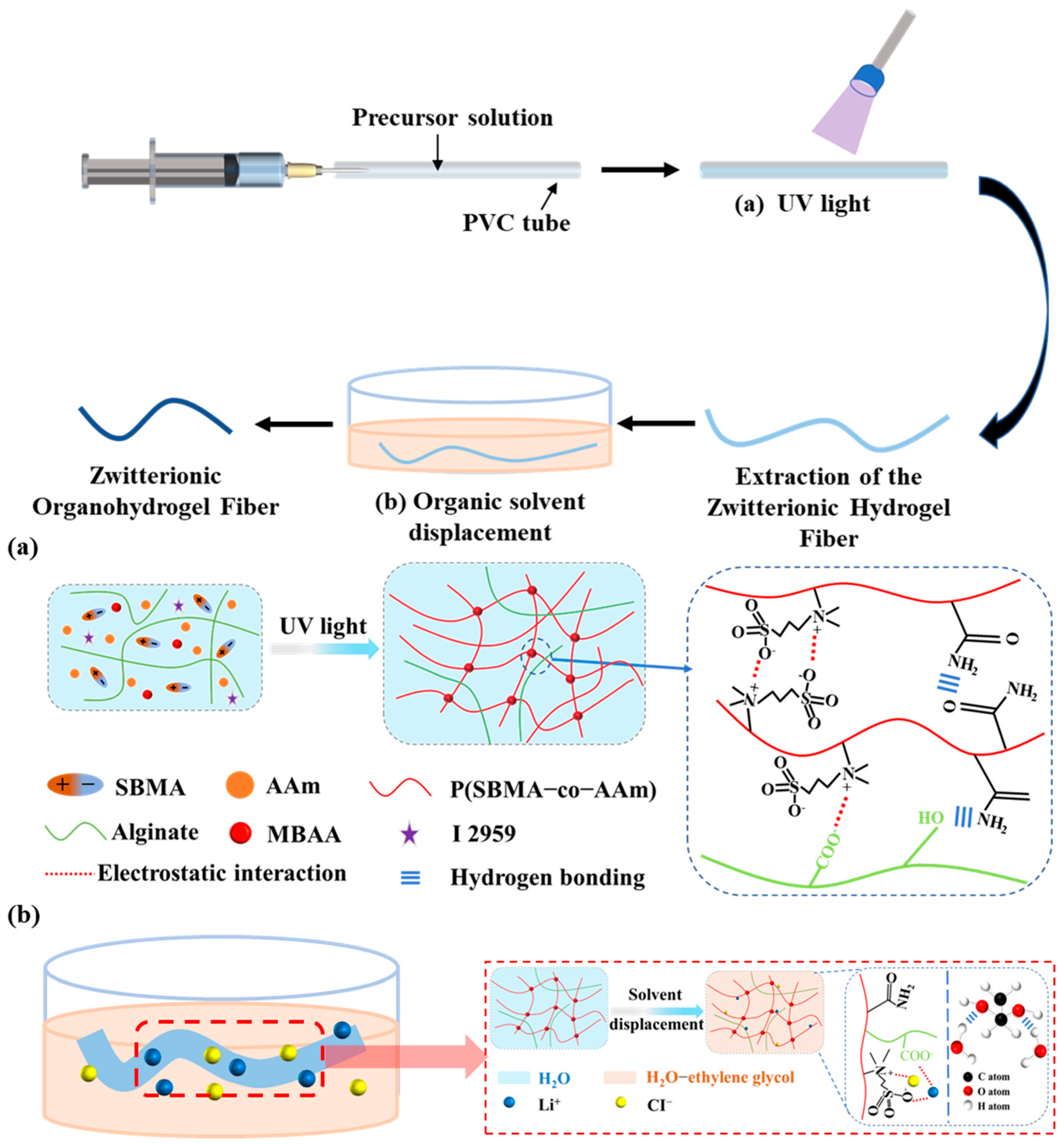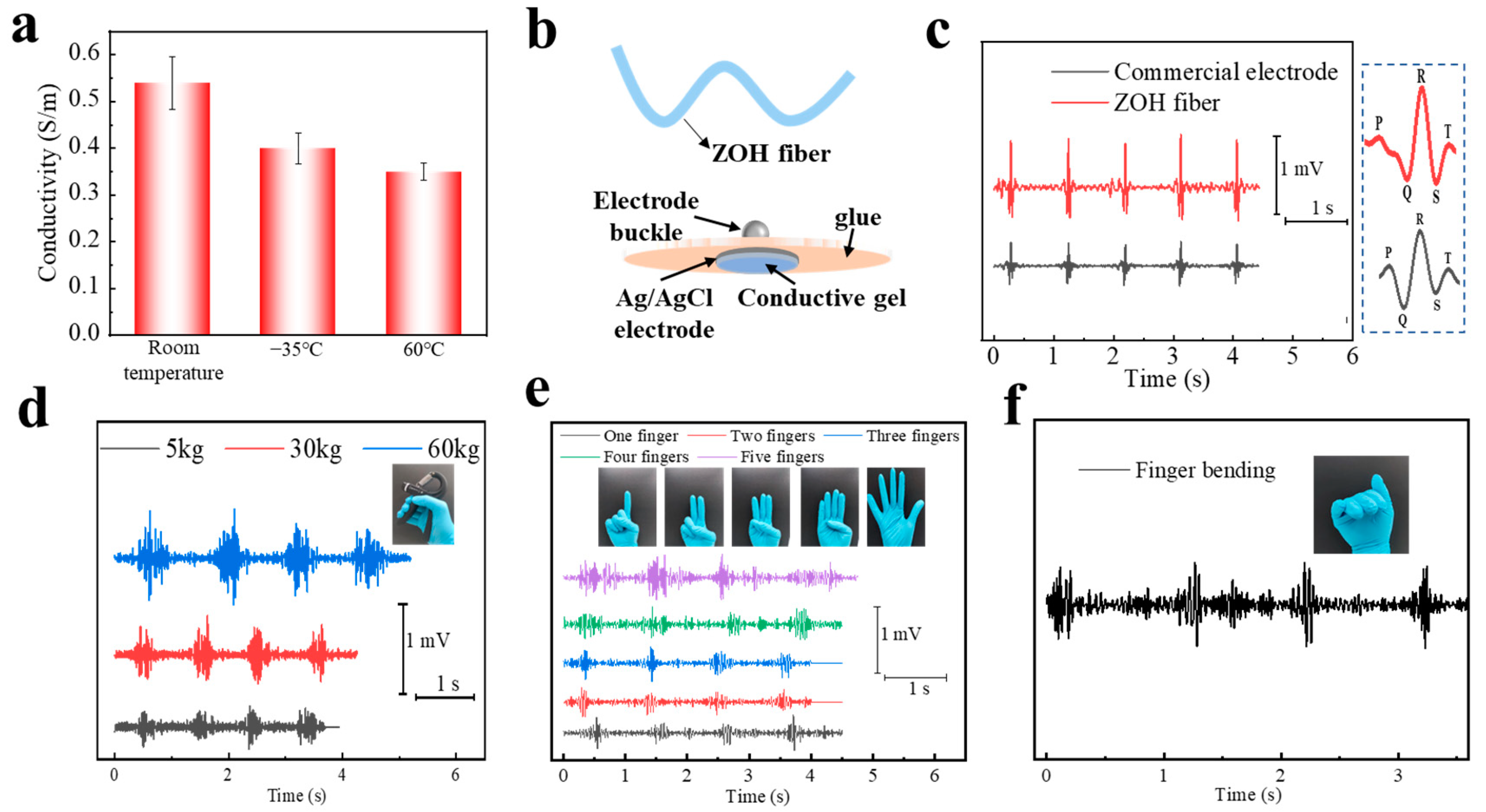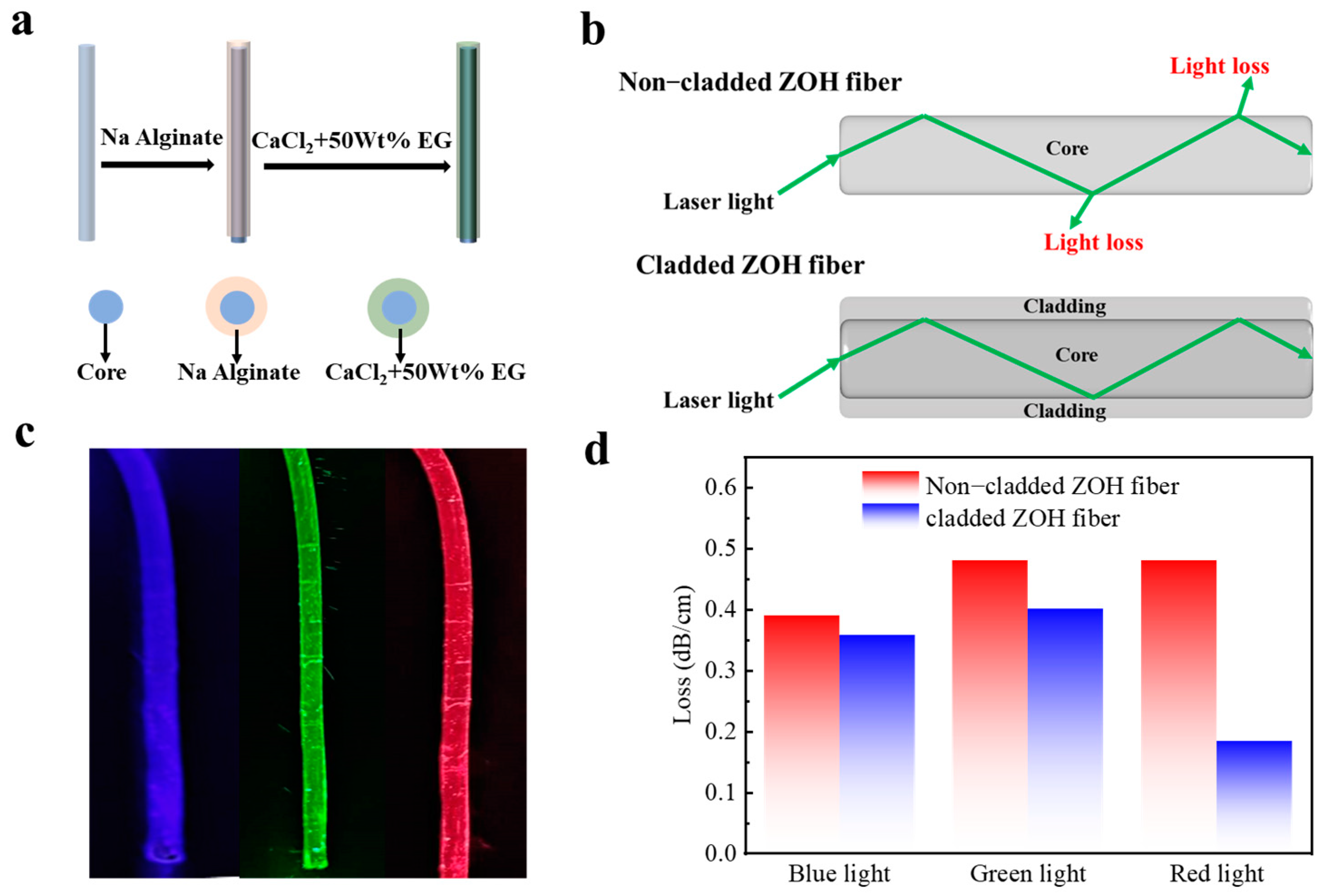High-Performance Zwitterionic Organohydrogel Fiber in Bioelectronics for Monitoring Bioinformation
Abstract
1. Introduction
2. Materials and Methods
2.1. Materials
2.2. Preparation of the ZOH Fiber
2.3. Mechanical Tests
2.4. Electrical Tests
2.5. Long Term Stability Test
2.6. Visible Light Transmittance Test
2.7. Differential Scanning Calorimetry (DSC) Tests
2.8. Bioelectrical Signal Test
2.9. Optical Measurements
3. Results and Discussion
4. Conclusions
Supplementary Materials
Author Contributions
Funding
Institutional Review Board Statement
Informed Consent Statement
Data Availability Statement
Conflicts of Interest
References
- Justus, K.B.; Hellebrekers, T.; Lewis, D.D.; Wood, A.; Ingham, C.; Majidi, C.; Leduc, R.C.; Tan, C. A biosensing soft robot: Autonomous parsing of chemical signals through integrated organic and inorganic interfaces. Sci. Robot. 2019, 4, eaax0765. [Google Scholar] [CrossRef] [PubMed]
- Shi, L.; Dong, H.; Reguera, G.; Beyenal, H.; Lu, A.; Liu, J.; Yu, H.Q.; Fredrickson, J.K. Extracellular electron transfer mechanisms between microorganisms and minerals. Nat. Rev. Microbiol. 2016, 14, 651–662. [Google Scholar] [CrossRef] [PubMed]
- Dixon, T.A.; Williams, T.C.; Pretorius, I.S. Sensing the future of bio-informational engineering. Nat. Commun. 2021, 12, 388. [Google Scholar] [CrossRef] [PubMed]
- Yuk, H.; Lu, B.; Zhao, X. Hydrogel bioelectronics. Chem. Soc. Rev. 2019, 48, 1642–1667. [Google Scholar] [CrossRef] [PubMed]
- Berggren, M.; Głowacki, E.D.; Simon, D.T.; Stavrinidou, E.; Tybrandt, K. In vivo organic bioelectronics for neuromodulation. Chem. Rev. 2022, 122, 4826–4846. [Google Scholar] [CrossRef]
- Chen, Y.; Zhang, Y.; Liang, Z.; Cao, Y.; Han, Z.; Feng, X. Flexible inorganic bioelectronics. NPJ Flex. Electron. 2020, 4, 2. [Google Scholar] [CrossRef]
- Fu, F.; Wang, J.; Zeng, H.; Yu, J. Functional conductive hydrogels for bioelectronics. ACS Mater. Lett. 2020, 2, 1287–1301. [Google Scholar] [CrossRef]
- Wang, T.; Song, J.; Liu, R.; Chan, S.; Wang, K.; Su, Y.; Li, P.; Huang, W. Motion detecting, temperature alarming, and wireless wearable bioelectronics based on intrinsically antibacterial conductive hydrogels. ACS Appl. Mater. Interfaces. 2022, 14, 14596–14606. [Google Scholar] [CrossRef]
- Yang, M.; Ren, X.; Yang, T.; Xu, C.; Ye, Y.; Sun, Z.; Kong, L.; Wang, B.; Luo, Z. Polypyrrole/sulfonated multi-walled carbon nanotubes conductive hydrogel for electrochemical sensing of living cells. Chem. Eng. J. 2021, 418, 129483. [Google Scholar] [CrossRef]
- Han, L.; Yan, L.; Wang, M.; Fang, L.; Zhou, J.; Lu, X. Transparent, adhesive, and conductive hydrogel for soft bioelectronics based on light-transmitting polydopamine-doped polypyrrole nanofibrils. Chem. Mater. 2018, 30, 5561–5572. [Google Scholar] [CrossRef]
- Han, I.K.; Song, K.I.; Jung, S.M.; Jo, Y.; Kwon, J.; Chung, T.; Yoo, S.; Jang, J.; Kim, Y.; Hwang, D.S.; et al. Electroconductive, adhesive, non-Swelling, and viscoelastic hydrogels for bioelectronic. Adv. Mater. 2022, 2203431. [Google Scholar] [CrossRef] [PubMed]
- Gong, Y.; Cheng, Y.; Hu, Y. Preparation of polymer conductive hydrogel and its application in flexible wearable electronic devices. Prog. Chem. 2021, 34, 616. [Google Scholar]
- Wang, Z.; Cong, Y.; Fu, J. Stretchable and tough conductive hydrogels for flexible pressure and strain sensors. J. Mater. Chem. B 2020, 8, 3437–3459. [Google Scholar] [CrossRef] [PubMed]
- Duan, J.; Wen, H.; Zong, S.; Li, T.; Lv, H.; Liu, L. Soft/hard controllable conversion galactomannan ionic conductive hydrogel as a flexible sensor. ACS Appl. Electron. Ma. 2021, 3, 5000–5014. [Google Scholar] [CrossRef]
- Wang, Y.; Gao, G.; Ren, X. Graphene assisted ion-conductive hydrogel with super sensitivity for strain sensor. Polymer 2021, 215, 123340. [Google Scholar] [CrossRef]
- Sun, X.; Yao, F.; Li, J. Nanocomposite hydrogel-based strain and pressure sensors: A review. J. Mater. Chem. A 2020, 8, 18605–18623. [Google Scholar] [CrossRef]
- Yang, C.; Suo, Z. Hydrogel ionotronics. Nat. Rev. Mater. 2018, 3, 125–142. [Google Scholar] [CrossRef]
- Wang, H.; Li, Z.; Zuo, M.; Zeng, X.; Tang, X.; Sun, Y.; Lin, L. Stretchable, freezing-tolerant conductive hydrogel for wearable electronics reinforced by cellulose nanocrystals toward multiple hydrogen bonding. Carbohyd. Polym. 2022, 280, 119018. [Google Scholar] [CrossRef]
- Li, S.; Zhou, X.; Dong, Y.; Li, J. Flexible self-repairing materials for wearable sensing applications: Elastomers and hydrogels. Macromol. Rapid. Comm. 2020, 41, 2000444. [Google Scholar] [CrossRef]
- Liu, C.; Li, F.; Li, G.; Li, P.; Hu, A.; Cui, Z.; Cong, Z.; Niu, J. Zwitterionic hydrogel electrolyte with tunable mechanical and electrochemical properties for a wearable motion and thermal sensor. ACS Appl. Mater. Interfaces. 2022, 14, 9608–9617. [Google Scholar] [CrossRef] [PubMed]
- Diao, W.; Wu, L.; Ma, X.; Zhuang, Z.; Li, S.; Bu, X.; Fang, Y. Highly stretchable, ionic conductive and self-recoverable zwitterionic polyelectrolyte-based hydrogels by introducing multiple supramolecular sacrificial bonds in double network. J. Appl. Polym. Sci. 2019, 136, 47783. [Google Scholar] [CrossRef]
- Liu, H.; Yang, L.; Dou, B.; Lan, J.; Shang, J.; Lin, S. Zwitterionic hydrogel-coated cotton fabrics with underwater superoleophobic, self-healing and anti-fouling performances for oil-water separation. Sep. Purif. Technol. 2021, 279, 119789. [Google Scholar] [CrossRef]
- Hu, X.; Zhang, P.; Liu, J.; Guan, H.; Xie, R.; Cai, L.; Guo, J.; Wang, L.; Tian, Y.; Qiu, X. A self-association cross-linked conductive zwitterionic hydrogel as a myocardial patch for restoring cardiac function. Chem. Eng. J. 2022, 446, 136988. [Google Scholar] [CrossRef]
- Wang, Z.; Chen, J.; Wang, L.; Gao, G.; Zhou, Y.; Wang, R.; Xu, T.; Yin, J.; Fu, J. Flexible and wearable strain sensors based on tough and self-adhesive ion conducting hydrogels. J. Mater. Chem. B 2019, 7, 24–29. [Google Scholar] [CrossRef] [PubMed]
- Ding, Q.; Wu, Z.; Tao, K.; Wei, Y.; Wang, W.; Yang, B.; Xie, X.; Wu, J. Environment tolerant, adaptable and stretchable organohydrogels: Preparation, optimization, and applications. Mater. Horiz. 2022, 9, 1356–1386. [Google Scholar] [CrossRef] [PubMed]
- Luo, J.; Xing, Y.; Sun, C.; Fan, L.; Shi, H.; Zhang, Q.; Li, Y.; Hou, C.; Wang, H. A bio-adhesive ion-conducting organohydrogel as a high-performance non-invasive interface for bioelectronics. Chem. Eng. J. 2022, 427, 130886. [Google Scholar] [CrossRef]
- Yang, J.; Kang, Q.; Zhang, B.; Fang, X.; Liu, S.; Qin, G.; Chen, Q. Strong, tough, anti-freezing, non-drying and sensitive ionic sensor based on fully physical cross-linked double network hydrogel. Mat. Sci. Eng. C Mater. 2021, 130, 112452. [Google Scholar] [CrossRef] [PubMed]
- Gao, Y.; Gao, Y.; Zhang, Z.; Wang, Y.; Ren, X.; Jia, F.; Gao, G. Highly conductive hydrogel sensors driven by amylose with freezing and dehydration resistances. J. Mater. Chem. C 2022, 10, 12873–12882. [Google Scholar] [CrossRef]
- Ye, Y.; Zhang, Y.; Chen, Y.; Han, X.; Jiang, F. Cellulose nanofibrils enhanced, strong, stretchable, freezing-tolerant ionic conductive organohydrogel for multi-functional sensors. Adv. Funct. Mater. 2020, 30, 2003430. [Google Scholar] [CrossRef]
- Sun, W.; Yang, J.; Ji, X.; Jiang, H.; Gai, L.; Li, X.; Liu, L. Antifreezing zwitterionic hydrogel electrolyte with high conductivity at subzero temperature for flexible sensor and supercapacitor. Sustain. Mater. Technol. 2022, 32, e00437. [Google Scholar] [CrossRef]
- Li, X.; Lou, D.; Wang, H.; Sun, X.; Li, J.; Liu, Y. Flexible supercapacitor based on organohydrogel electrolyte with long-term anti-freezing and anti-drying property. Adv. Funct. Mater. 2020, 30, 2007291. [Google Scholar] [CrossRef]
- Qiao, L.; Liu, C.; Liu, C.; Yang, L.; Zhang, M.; Liu, W.; Wang, J.; Jian, X. Self-healing alginate hydrogel based on dynamic acylhydrazone and multiple hydrogen bonds. J. Mater. Sci. 2019, 54, 8814–8828. [Google Scholar] [CrossRef]
- Tao, K.; Chen, Z.; Yu, J.; Zeng, H.; Wu, Z.; Yuan, W. Ultra-Sensitive, deformable, and transparent triboelectric tactile sensor based on micro-pyramid patterned ionic hydrogel for interactive human–machine interfaces. Adv. Sci. 2022, 9, 2104168. [Google Scholar] [CrossRef] [PubMed]
- Zhang, J.; Zeng, L.; Qiao, Z.; Wang, J.; Jiang, X.; Zhang, Y.; Yang, H. Functionalizing double-network hydrogels for applications in remote actuation and in low-temperature strain sensing. ACS Appl. Mater. Interfaces 2020, 12, 30247–30258. [Google Scholar] [CrossRef] [PubMed]
- Jian, Y.; Handschuh-Wang, S.; Zhang, J.; Lu, W.; Zhou, X.; Chen, T. Biomimetic anti-freezing polymeric hydrogels: Keeping soft-wet materials active in cold environments. Mater. Horiz. 2021, 8, 351–369. [Google Scholar] [CrossRef] [PubMed]
- Sui, Y.; Yu, M.; Xu, Y.; Ji, X. Low-temperature aqueous batteries: Challenges and opportunities. J. Electrochem. Soc. 2022, 169, 030537. [Google Scholar] [CrossRef]
- Yu, K.; Liu, Y.; Yang, Y. Review on form-stable inorganic hydrated salt phase change materials: Preparation, characterization and effect on the thermophysical properties. Appl. Energy 2021, 292, 116845. [Google Scholar] [CrossRef]
- Zhao, J.; Jiao, K.; Yang, J.; He, C.; Wang, H. Mechanically strong and thermosensitive macromolecular microsphere composite poly (N-isopropylacrylamide) hydrogels. Polymer 2013, 54, 1596–1602. [Google Scholar] [CrossRef]
- Su, G.; Cao, J.; Zhang, X.; Zhang, Y.; Yin, S.; Jia, L.; Guo, Q.; Zhang, X.; Zhang, J.; Zhou, T. Human-tissue-inspired anti-fatigue-fracture hydrogel for a sensitive wide-range human–machine interface. J. Mater. Chem A 2020, 8, 2074–2082. [Google Scholar] [CrossRef]
- Nazempour, R.; Zhang, Q.; Fu, R.; Sheng, X. Biocompatible and implantable optical fibers and waveguides for biomedicine. Materials 2018, 11, 1283. [Google Scholar] [CrossRef]
- Yetisen, A.K.; Jiang, N.; Fallahi, A.; Montelongo, Y.; Ruizesparza, G.U.; Tamayol, A.; Zhang, Y.; Mahmood, I.; Yang, S.A.; Yun, S.H.; et al. Glucose-sensitive hydrogel optical fibers functionalized with phenylboronic acid. Adv. Mater. 2017, 29, 1606380. [Google Scholar] [CrossRef] [PubMed]
- Chen, G.; Wang, G.; Tan, X.; Hou, K.; Meng, Q.; Zhao, P.; Wang, Z.; Zhang, J.; Zhou, Z.; Zhu, M.; et al. Integrated dynamic wet spinning of core-sheath hydrogel fibers for optical-to-brain/tissue communications. Natl. Sci. Rev. 2021, 8, nwaa209. [Google Scholar] [CrossRef] [PubMed]
- Zhang, M.; Chen, S.; Sheng, N.; Wang, B.; Wu, Z.; Liang, Q.; Han, Z.; Wang, H. Spinning continuous high-strength bacterial cellulose hydrogel fibers for multifunctional bioelectronic interfaces. J. Mater. Chem. A 2021, 9, 12574–12583. [Google Scholar] [CrossRef]
- Jiang, N.; Ahmed, R.; Rifat, A.A.; Guo, J.; Yin, Y.; Montelongo, Y.; Butt, H.; Yetisen, A.K. Functionalized flexible soft polymer optical fibers for laser photomedicine. Adv. Opt. Mater. 2018, 6, 1701118. [Google Scholar] [CrossRef]
- Zhao, L.; Wang, B.; Mao, Z.; Sui, X.; Feng, X. Nonvolatile, stretchable and adhesive ionogel fiber sensor designed for extreme environments. Chem. Eng. J. 2022, 433, 133500. [Google Scholar] [CrossRef]
- Song, J.; Chen, S.; Sun, L.; Guo, Y.; Zhang, L.; Wang, S.; Xuan, H.; Guan, Q.; You, Z. Mechanically and electronically robust transparent organohydrogel fibers. Adv. Mater. 2020, 32, 1906994. [Google Scholar] [CrossRef]
- Guo, J.; Liu, X.; Jiang, N.; Yetisen, A.K.; Yuk, H.; Yang, C.; Khademhosseini, A.; Zhao, X.H.; Yun, S.H. Highly stretchable, strain sensing hydrogel optical fibers. Adv. Mater. 2016, 28, 10244–10249. [Google Scholar] [CrossRef]
- Zhao, X.; Chen, F.; Li, Y.; Lu, H.; Zhang, N.; Ma, M. Bioinspired ultra-stretchable and anti-freezing conductive hydrogel fibers with ordered and reversible polymer chain alignment. Nat. Commun. 2018, 9, 3579. [Google Scholar] [CrossRef]
- Wang, X.; Wang, X.; Pi, M.; Ran, R. High-strength, highly conductive and woven organic hydrogel fibers for flexible electronics. Chem. Eng. J. 2022, 428, 131172. [Google Scholar] [CrossRef]





| Full Name | Abbreviation |
|---|---|
| Carboxylbetaine methacrylate | CBMA |
| Hydroxyethyl methacrylate | HEMA |
| [2-(methacryloyloxy) ethyl] dimethyl-(3-sulfopropyl) ammonium hydroxide | SBMA |
| Ethylene glycol | EG |
| Dimethyl sulfoxide | DMSO |
| Zwitterionic organohydrogel | ZOH |
| Zwitterionic hydrogel | ZH |
| Electrocardiogram | ECG |
| Electromyogram | EMG |
| Sodium alginate | SA |
| Lithium chloride | LiCl |
| Acrylamide | AAm |
| N, N’-methylenebisacrylamide | MBAA |
| 2-hydroxy-4’-(2-hydroxythoxy)-2-methylpropiophenone | I2959 |
| Differential scanning calorimetry | DSC |
| Materials | Breaking Elongation (%) | Ion Conductivity (S/m) | Transparency (%) | Optical Loss (dB/cm) | Reference |
|---|---|---|---|---|---|
| ZOH fiber | 905.8 | 0.54 | 92.1 | 0.17 | This work |
| PEGDA/AAm | 63 | - | 94.1 | 0.18 | 42 |
| BC | 84 | 0.03 | 80~90 | 5.1 | 43 |
| AAm/PEGDA/CA | - | - | - | 0.28 | 44 |
| AAm/SBMA/[EMIM][DCA] | 1100 | 2 | 90 | - | 45 |
| HEA/SA/PEGDA | ~400 | >90 | 46 | ||
| AAm/SA | 730 | - | - | 0.45 | 47 |
| PAAS/PMA | 1180 ± 100 | 1.8 | - | - | 48 |
| PVA/HEC | 400.3 | - | - | - | 49 |
Disclaimer/Publisher’s Note: The statements, opinions and data contained in all publications are solely those of the individual author(s) and contributor(s) and not of MDPI and/or the editor(s). MDPI and/or the editor(s) disclaim responsibility for any injury to people or property resulting from any ideas, methods, instructions or products referred to in the content. |
© 2023 by the authors. Licensee MDPI, Basel, Switzerland. This article is an open access article distributed under the terms and conditions of the Creative Commons Attribution (CC BY) license (https://creativecommons.org/licenses/by/4.0/).
Share and Cite
Xia, J.; Luo, J.; Chang, B.; Sun, C.; Li, K.; Zhang, Q.; Li, Y.; Wang, H.; Hou, C. High-Performance Zwitterionic Organohydrogel Fiber in Bioelectronics for Monitoring Bioinformation. Biosensors 2023, 13, 115. https://doi.org/10.3390/bios13010115
Xia J, Luo J, Chang B, Sun C, Li K, Zhang Q, Li Y, Wang H, Hou C. High-Performance Zwitterionic Organohydrogel Fiber in Bioelectronics for Monitoring Bioinformation. Biosensors. 2023; 13(1):115. https://doi.org/10.3390/bios13010115
Chicago/Turabian StyleXia, Jun, Jiabei Luo, Boya Chang, Chuanyue Sun, Kerui Li, Qinghong Zhang, Yaogang Li, Hongzhi Wang, and Chengyi Hou. 2023. "High-Performance Zwitterionic Organohydrogel Fiber in Bioelectronics for Monitoring Bioinformation" Biosensors 13, no. 1: 115. https://doi.org/10.3390/bios13010115
APA StyleXia, J., Luo, J., Chang, B., Sun, C., Li, K., Zhang, Q., Li, Y., Wang, H., & Hou, C. (2023). High-Performance Zwitterionic Organohydrogel Fiber in Bioelectronics for Monitoring Bioinformation. Biosensors, 13(1), 115. https://doi.org/10.3390/bios13010115





